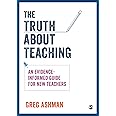Enjoy Prime FREE for 30 days
Here's what Amazon Prime has to offer:
| Delivery Speed |  |
|---|---|
| Same-Day Delivery (in select cities) | FREE |
| One-Day Delivery | FREE |
| Two-Day Delivery | FREE |

Download the free Kindle app and start reading Kindle books instantly on your smartphone, tablet or computer – no Kindle device required.
Read instantly on your browser with Kindle for Web.
Using your mobile phone camera, scan the code below and download the Kindle app.

Power of Explicit Teaching and Direct Instruction Paperback – Jan. 15 2021
Purchase options and add-ons
Direct instruction and explicit teaching can offer you a shorter, straighter route to developing effective learning in your classroom.
In this smart and accessible book, Greg Ashman explores how you can harness the potential of these often misunderstood and misapplied teaching methods to achieve positive learning outcomes for the students you teach.
It investigates key foundational principles, combined with thoughtful commentary on what these mean in classroom practice and an examination of relevant research and theories from cognitive psychology that substantiate these approaches to teaching and learning.
- ISBN-101529731607
- ISBN-13978-1529731606
- Edition1st
- PublisherCorwin
- Publication dateJan. 15 2021
- LanguageEnglish
- Dimensions17 x 0.89 x 24.2 cm
- Print length152 pages
Frequently bought together

Customers who bought this item also bought
From the Publisher


The evidence base for explicit teaching and direct instruction is strong. It is not inferior to asking students to figure things out for themselves – quite the reverse. Once you take responsibility for fully communicating complex concepts, rather than somehow infusing them incidentally into students’ minds, it becomes a series of technical challenges.
What is the best way of presenting a fraction? How can we communicate Lenz’s law to avoid a common misconcep¬tion? Exactly what do students need to know in order to discuss Truman’s decision to use atomic weapons against Japan?
This is your essential guide to how direct instruction and explicit teaching can make you a better teacher.
|
|
|
|
|
|---|---|---|---|
|
|
|
|
|

Product description
About the Author
Product details
- Publisher : Corwin; 1st edition (Jan. 15 2021)
- Language : English
- Paperback : 152 pages
- ISBN-10 : 1529731607
- ISBN-13 : 978-1529731606
- Item weight : 270 g
- Dimensions : 17 x 0.89 x 24.2 cm
- Best Sellers Rank: #583,290 in Books (See Top 100 in Books)
- #420 in Business Education (Books)
- #87,275 in Textbooks
- Customer Reviews:
Customer reviews
Top reviews from other countries
Given the usually outdated education instruction, the author only mentions working memory halfway through the book. And he does not mention the crucial concepts of fluency and automaticity acquired through practice, so that items can be linked and pass into one through working memory. He misses the no. 1 implication of working memory, that speed is the prerequisite of all performance. We must either recall in 2-3 seconds, or we can't deal with a situation. Knowledge that is recalled after a test or a real-life situation is of little use.
Given the above, the author could specify that inquiry and project-based approaches may work for high performers who are already automatic in the component skills. For the rest, explicit, bottom-up instruction and practice create the needed fluency and automaticity needed for more complex work.
For explanations, the author to cognitive load theory. It's a 1990s interpretation of working-memory research that most Australian educationists use. It's better than no working memory reference, but it is not very precise. But explanations aside, the book is accurate and fairly succinct.
The only hiccup in the reading is in the last third of the book, where the author moves from the argument for explicit/direct instruction to ideal teaching methods. When approaching Cognitive Load Theory (not as scary as it sounds), he takes a minor detour into "element interactivity". This is a topic of particular interest to the author and he has written research papers on it, so I understand why he wanted to include it. However, I found it overly technical and the two diagrams included were a bit hard to interpret. Before I loaned this book to somebody, I'd be inclined to scratch out these sections with a black marker (sorry, author).
The case for explicit instruction is argued expertly with research, data and even a touch of humour. An empowering read.













